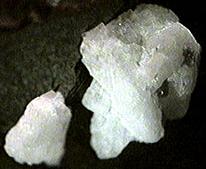
PERSONAL DETAILS:
MAIN PAGE:
SPOT PRICES:
DEPOSIT MODELS:
IDENTIFYING MINERALS:
CARBONATES:
HALIDES
NATIVE
ELEMENTS:
OXIDES:
SILICATES:
SULPHATES:
SULPHIDES:
LINKS:
SIGN
GUESTBOOK:
View Guestbook:
View Old Guestbook:


Quartz: Silicon Oxide (copyright theimage.com)
can exhibit a wide variety of colours. Crystals are usually six sided prisms terminating
in six prism faces. No cleavage exists and hardness is 7. Being one of the commonest minerals
on the earth it is associated with all three major rock groups: igneous, metamorphic and
sedimentary. It is also a major gangue mineral in veins and cavities. Other forms of quartz
(depending on impurities) include milky quartz, smokey quartz, blue quartz, amethyst, rose
quartz and tiger's eye.
Its use in industry is increased because of its piezoelectric properties.

Biotite: Hydrous Potassium Aluminium Silicate (copyright theimage.com)
more commonly platy, platy aggregates or disseminated but can be found with a tabular habit.
Hardness is between 2.5 to 3 and there is a perfect basal cleavage. Biotite is an important mineral
in many igneous rocks, for example, granites, pegmatites, lamprophyres and diorites. It can also
be found in some lavas, sedimentary and metamorphic rocks. World class crystals have been
found in Russia, Greenland, Italy (Vesuvius) and USA (Alaska).

Muscovite: Hydrous Potassium Aluminium Silicate (copyright theimage.com)
and hexagonal in outline but can also be found as foliated masses, flakes or plates. Hardness
is between 2.5-3 with a perfect basal cleavage. Muscovite is one of the most abundant minerals
present on earth. In igneous rocks it can be found in pegmatites and granites, in metamorphic
rocks it is found in schists and gneisses while in sedimentary deposits it is present in sandstones and sands. World class crystals have been found in pegmatites in Canada (Ontario), USA
(South Dakota), India, Brazil and Switzerland (Alps).
paper, fireproof paint and rubber.

Plagioclase Feldspars: Sodium or Calcium Aluminium Silicates (copyright theimage.com)
Plagioclase is generally white or grey in colour but some varities contain hints of pink,
green and blue. The lustre is commmonly vitreous. Crystals are prismatic or tabular in habit.
Hardness ranges from 6 to 6.5 with two good cleavages (striations found on cleavage planes which helps distinguish plagioclase from alkali feldspar). Plagioclase is widely distributed in
igneous rocks with sodium rich plagioclase in granite and calcium rich plagioclase in basalt and gabbro. Plagioclase feldspar, especially the sodium rich variety is an extremely well distributed rock forming mineral however, some world class deposits of labradorite have been found in
Norway and Canada (Labrador).

Alkali Feldspars: Potassium Aluminium Silicates (copyright theimage.com)
the most common. Orthoclase is generally white to pink in colour, while sanidine and microcline
are generally colourless or grey. All have a vitreous/pearly lustre. Alkali feldspars have a hardness which is between 6 and 6.5 and a very diagnostic feature of 2 perfect cleavages. Habit varies with sanidine showing tabular and prismatic crystals while orthoclase and microcline generally exist as prismatic crystals. Orthoclase is the commonest of the alkali feldspars and can be found in most
igneous and metamorphic rocks, sanidine forms phenocrysts in volcanic rocks and in high
temperature metamorphics while microcline occurs manily in granites, schists and gneisses.
World class deposits have been found in former Czechoslovakia for orthoclase, Sicily and Elba for sanidine and Colorado for microcline.

Augite: Calcium Magnesium Iron Aluminium Silicate (copyright theimage.com)
with a vitreous lustre. Crystals illustrate a prismatic habit often with either stubby, sqaure or eight
sided cross sections. Hardness ranges from 5.5 to 6.5 with a good prismatic cleavage. Augite is a common mineral in plutonic rocks, (gabbros, peridotites), volcanic rocks (basalts) and high
temperature metamorphic rocks. World class deposits have been found in South Africa
(Bushveld), USA (Stillwater), Greenland (Skaergaard) and Italy (Vesuvius).

Tourmaline: Complex Borosilicate (copyright theimage.com)
and colourless do exist. Lustre is vitreous or resinous. Crystals are long and prismatic with vertical striations. Often curved and triangular in cross section. Tourmaline is very hard with a reference
number of between 7 and 7.5, clevage is poorly marked. Tourmaline is a common accessory
mineral in igneous rocks: granites (often associated with pegmatic dykes), metamorphic rocks:
gneisses and schists and sedimentary rocks: limestones and dolomites mainly as detritial grains.
World class crystals have been found in Italy (Elba), Switzerland, Brazil and U.S.A.
forms of Tourmaline are also used as semiprecious stones.

Hornblende: Complex Silicate (copyright theimage.com)
Crystals are prismatic but more commonly stubby. Hornblende exhibits a good prismatic cleavage
with a hardness of between 5 and 6. A common mineral in contact metamorphic marbles and
skarns but also in some mafic rocks, for example gabbros, diorites and ecologites. World class deposits found in Finland (Pargas), Sweden (Mansjo), Germany, U.S.A and Poland.
It has not been my intention to break any copyright rules, however, if I have stepped on someones toes, please Email me and I will be more than happy to rectify the situation.
